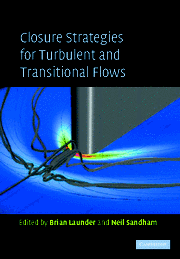21 - Joint Velocity-Scalar PDF Methods
Published online by Cambridge University Press: 06 July 2010
Summary
In this chapter the joint velocity-scalar PDF approach is described. This approach was mainly developed by S.B. Pope and includes from the start the complete one-point joint statistics of velocity and scalars. This is conceptually appealingb ecause it delivers in one framework closure models for Reynolds stresses, Reynolds fluxes and chemical source terms. The present text is based on the PhD thesis of H.A. Wouters (Wouters 1998), which can be consulted for further details and other applications.
The outline of this chapter is as follows. First the exact transport equation for the velocity-scalar PDF is introduced and the closure problem is discussed. Next the Monte Carlo solution method that is used to model and solve the PDF transport equation is described. Modellingof the unclosed terms describing acceleration in the turbulent flow are treated in some detail. The closure of the micromixingterms can be done alongparallel lines as is the case in the scalar PDF method discussed in [20] and is not elaborated here. A description of some methods for handlingcomplex chemistry is included.
In the final section results of test calculations are presented for a challengingtest case, combininga complex flow pattern with effects of high mixing rates and chemical kinetics. For this bluff-body-stabilized diffusion flame, the relative importance of modelingof the velocity, mixingand chemistry terms is studied.
PDF transport equation
From the full conservation equations given in [10], the transport equation for the joint velocity-scalar PDF fUϕ(V ,ψ; x, t) can be derived (Pope 1985).
By integrating this quantity over a range of values of V and ψ the probability that U and ϕ take values in these ranges is obtained. It is also useful to consider the joint velocity-scalar mass density function (MDF) defined as FUϕ(V,ψ, x; t) = ρ (ψ)fUϕ(V, ψ; x, t). The transport equation for the MDF reads in which the first two terms (1.1a) and (1.1b) on the right-hand side describe the evolution in velocity space and the last two terms (1.1c) and (1.1d) describe the evolution in scalar space. (The notation 〈A|B〉 denotes the conditional expectation value of A upon condition B). Terms (1.1a) and (1.1c) occur in closed form whereas the unclosed terms (1.1b) and (1.1d) contain conditional averages because these effects cannot be expressed in terms of the one-point distribution of U and ϕ.
- Type
- Chapter
- Information
- Closure Strategies for Turbulent and Transitional Flows , pp. 626 - 656Publisher: Cambridge University PressPrint publication year: 2002
- 4
- Cited by



